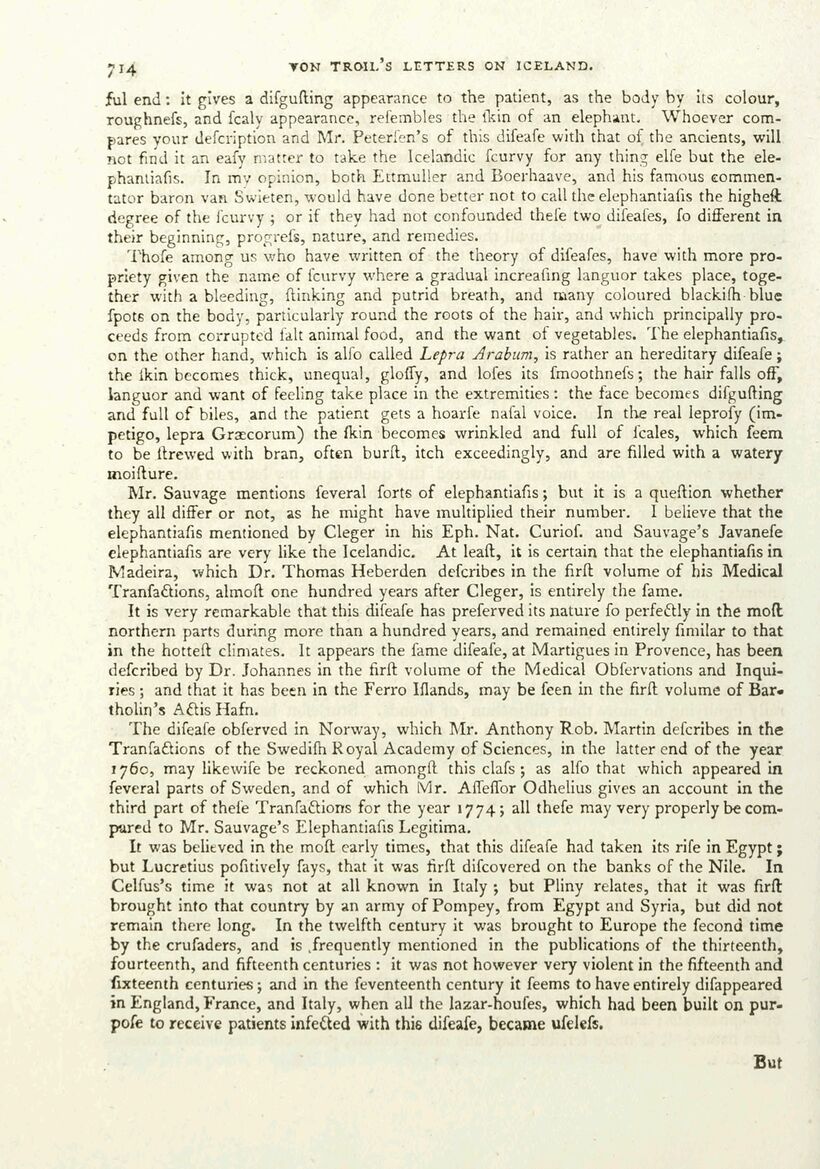
Full resolution (JPEG) - On this page / på denna sida - Pages ...

<< prev. page << föreg. sida << >> nästa sida >> next page >>
Below is the raw OCR text
from the above scanned image.
Do you see an error? Proofread the page now!
Här nedan syns maskintolkade texten från faksimilbilden ovan.
Ser du något fel? Korrekturläs sidan nu!
This page has never been proofread. / Denna sida har aldrig korrekturlästs.
7314 VON TROIL’S LETTERS ON ICELAND.
ful end: it gives a difgufting appearance to the patient, as the body by its colour,
roughnefs, and fcaly appearance, refembles the fkin of an elephant. Whoever com-
pares your defcription and Mr. Peterfen’s of this difeafe with that of the ancients, will
not find it an eafy matter to take the Icelandic {curvy for any thing elfe but the ele-
phantiafis. In my opinion, both Ettmuller and Boerhaave, and his famous commen-
tator baron vam Swieten, would have done better not to call the elephantiafis the higheft
degree of the {curvy ; or if they had not confounded thele two difeafes, fo different in
their beginning, progrefs, nature, and remedies.
Thofe among us who have written of the theory of difeafes, have with more pro-
priety given the name of fcurvy where a gradual increafing languor takes place, toge-
ther with a bleeding, ftinking and putrid breath, and many coloured blackifh- blue
fpote on the body, particularly round the roots of the hair, and which principally pro-
ceeds from corrupted falt animal food, and the want of vegetables. ‘Che elephantiafis,
on the other hand, which is alfo called Lepra Arabum, is rather an hereditary difeafe ;
the {kin becomes thick, unequal, gloffy, and lofes its {moothnefs; the hair falls off,
Janguor and want of feeling take place in the extremities: the face becomes difgufting
and full of biles, and the patient gets a hoarfe nafal voice. In the real leprofy (im-
petigo, lepra Grecorum) the fkin becomes wrinkled and full of {cales, which feem
to be ftrewed with bran, often burit, itch exceedingly, and are filled with a watery
moifture.
Mr. Sauvage mentions feveral forts of elephantiafis; but it is a queftion whether
they all differ or not, as he might have multiplied their number. 1 believe that the
elephantiafis mentioned by Cleger in his Eph. Nat. Curiof. and Sauvage’s Javanefe
elephantiafis are very like the Icelandic. At leaft, it is certain that the elephantiafis in
Madeira, which Dr. Thomas Heberden defcribes in the firft volume of his Medical
‘Tranfactions, almoft one hundred years after Cleger, is entirely the fame.
It is very remarkable that this difeafe has preferved its nature fo perfectly in the moft
northern parts during more than a hundred years, and remained entirely fimilar to that
in the hotteft climates. It appears the fame difeafe, at Martigues in Provence, has been
defcribed by Dr. Johannes in the firft volume of the Medical Obfervations and Inqui-
ries; and that it has been in the Ferro Iflands, may be feen in the firft volume of Bare
tholin’s Actis Hafn.
The difeafe obferved in Norway, which Mr. Anthony Rob. Martin defcribes in the
Tranfations of the Swedifh Royal Academy of Sciences, in the latter end of the year
1760, may likewife be reckoned amongft this clafs; as alfo that which appeared in
feveral parts of Sweden, and of which Mr. Affeflor Odhelius gives an account in the
third part of thefe Tranfactions for the year 1774; all thefe may very properly be com-
pared to Mr. Sauvage’s Elephantiafis Legitima.
It was believed in the moft early times, that this difeafe had taken its rife in Egypt 5
but Lucretius pofitively fays, that it was firft difcovered on the banks of the Nile. In
Celfus’s time it was not at all known in Italy ; but Pliny relates, that it was firft
brought into that country by an army of Pompey, from Egypt and Syria, but did not
remain there long. In the twelfth century it was brought to Europe the fecond time
by the crufaders, and is frequently mentioned in the publications of the thirteenth,
fourteenth, and fifteenth centuries: it was not however very violent in the fifteenth and
fixteenth centuries ; and in the feventeenth century it feems to have entirely difappeared
in England, France, and Italy, when all the lazar-houfes, which had been built on pur-
pofe to receive patients infected with this difeafe, became ufelefs.
But
<< prev. page << föreg. sida << >> nästa sida >> next page >>